Expert’s Rating
Pros
- Face- and eye-tracking are huge for social VR
- Full-colour passthrough will be a boon for MR apps
- Redesigned, compact controllers
- Convenient charging station
Cons
- Very expensive
- Can become uncomfortable to wear over time
- No full light blocker included in the box
Our Verdict
The Quest Pro is a capable headset that showcases what we should look forward to in the world of VR in the next few years, but the high price tag and comfort issues mean it’s only really for early adopters and those using it for work. Most people will still be perfectly happy with the standard Quest 2.
Best Prices Today: Meta Quest Pro
$1,499.99
The Meta Quest Pro is Meta’s magnum opus, the result of years of internal R&D and investment into VR and MR – that’s virtual reality and mixed reality.
It’s a high-end headset for VR and MR enthusiasts with a high-end price tag to match, sporting features including face- and eye-tracking, full-colour passthrough for mixed reality, improved hand tracking and the best performance of any standalone VR headset on the market right now.
The question is, is it worth upgrading from the Meta Quest 2 or should you wait for the Meta Quest 3 next year? The answer isn’t as simple as you might expect…
Design & Build
- Streamlined form factor
- Incredibly compact HMD
- Can get uncomfortable over longer sessions
Meta (Facebook’s parent company) has been clear from the start that the Meta Quest Pro is a different beast entirely from the standard Quest 2 (formerly Oculus), and that’s most evident from the design of the headset.
It’s a complete departure from the shape, material and colour scheme of the standard Quest 2, with a much smaller head-mounted display (HMD) and a rigid head strap with a crank adjustment system similar to that of Meta’s optional Quest 2 Elite Strap.
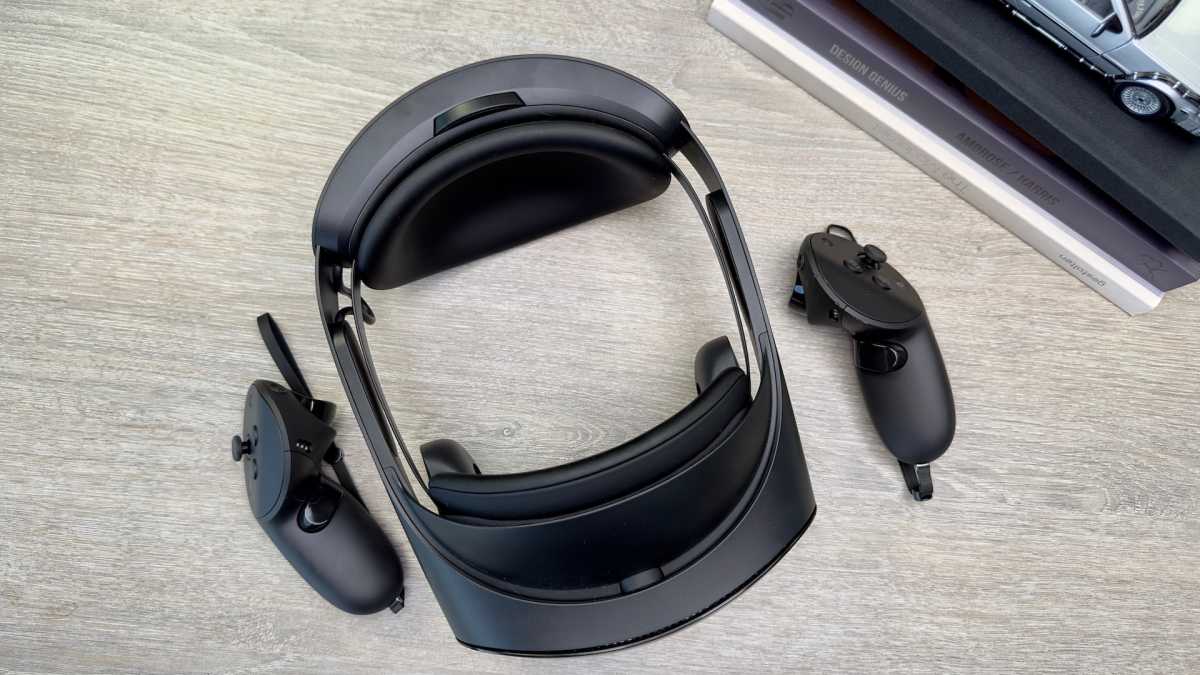
Lewis Painter / Foundry
The grey colour scheme of the Quest 2 has been swapped for an all-black affair, complete with a glossy front that houses the new colour passthrough cameras. It looks sleek, but the front can become a bit of a fingerprint magnet over time.
The HMD truly is a marvel of engineering, coming in at less than half the width of the Quest 2 at 196mm for a much more compact form factor on the face. That’s down to a combination of a new pancake lens system that’s much thinner than the standard Fresnel-based lens system and Meta shifting the battery to the rear of the headset for better weight distribution – particularly important considering the Quest Pro weighs 772g, compared to the Quest 2’s 503g.
The improved fit and better weight distribution should translate to a more comfortable experience when donning the headset, and while that is the case with shorter bursts, the headset can still become uncomfortable over longer periods of use.
I’ve noticed a build-up of pressure on the forehead on two of the longer VR sessions during my week and a bit with the headset that became so uncomfortable that I had to stop using the headset for a while. That can be alleviated by loosening the crank on the rear of the headset, but then the headset becomes loose and moves slightly during use.

Lewis Painter / Foundry
That also happened after running the Quest Pro’s built-in fit checker, utilising the face- and eye-tracking to confirm that I was wearing the headset correctly. It’s possible that others could have a more comfortable experience, but for me, the Quest Pro is better suited to shorter stints in VR.
Fit and comfort aside, the Quest Pro sports an impressively wide IPD (inter pupillary distance) adjustment of 55-75mm, which comfortably beats the 56-70mm of the Quest 2 and 62-72mm of the competing Pico 4 and should accommodate most people.
The IPD adjustment system is much more granular than the Quest 2 with its three presets, and the Quest Pro can accurately measure your IPD using inward-facing cameras, though you still have to move the lenses yourself to get the right fit.
Display & Audio
- New pancake lens system improves optics
- No resolution bump, but things look clearer than Quest 2
- Impressive spatial audio support
The visuals are no doubt a highlight of the Quest Pro, boasting impressive clarity, even towards the edge of the frame where Fresnel-based systems like the Quest 2 begin to fall over. That’s because the Quest Pro sports a new pancake lens system that allows the headset to be much more compact than the standard Quest while providing improved optics.
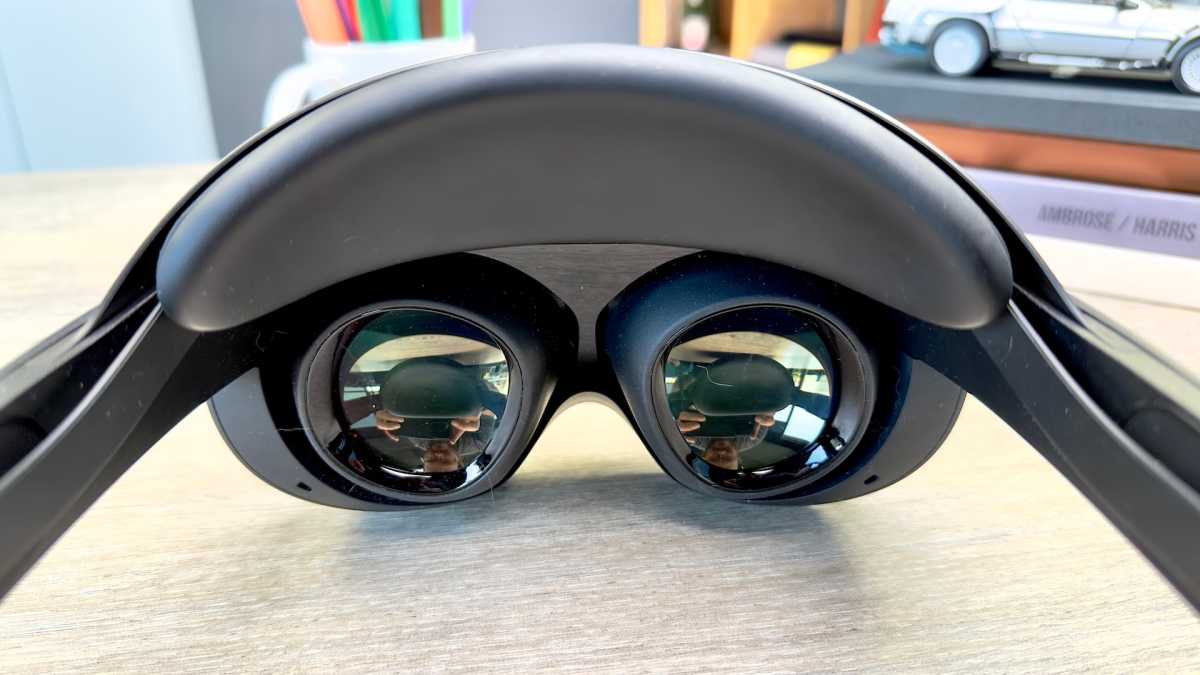
Lewis Painter / Foundry
Interestingly, the pancake optics seem to have a notable impact on overall image fidelity without any real increase to overall resolution, with the Quest Pro sporting a similar 1800 x 1920 resolution per eye as the standard Quest 2 despite looking much clearer and more vibrant overall. The Mini-LED backlighting does also help, providing a much brighter display with improved dynamic range.
It’s particularly interesting to note as the entry-level Quest 2 competitor, the Pico 4, has both a pancake lens system and higher resolution displays at 2160 x 2160 per eye while costing just £379 (around $400). If image quality is what’s most important to you, there could be a much cheaper option that could suit your needs.
Regardless of resolution specifics, there’s no noticeable screen door effect with the ability to clearly read text in VR without having to be right in front of it. That’s a boon not only for VR games, but working in virtual reality too.
The display is capped at 90Hz refresh rate in place of the experimental 120Hz of the Quest 2, but most people will struggle to notice the difference in everyday use.
The audio performance is equally as impressive despite no dedicated built-in headphones. Instead, the Quest Pro uses the same downward-firing speaker system as the Quest 2, which should be fine for both social VR and most VR games. I certainly had no complaints during my time with the headset.
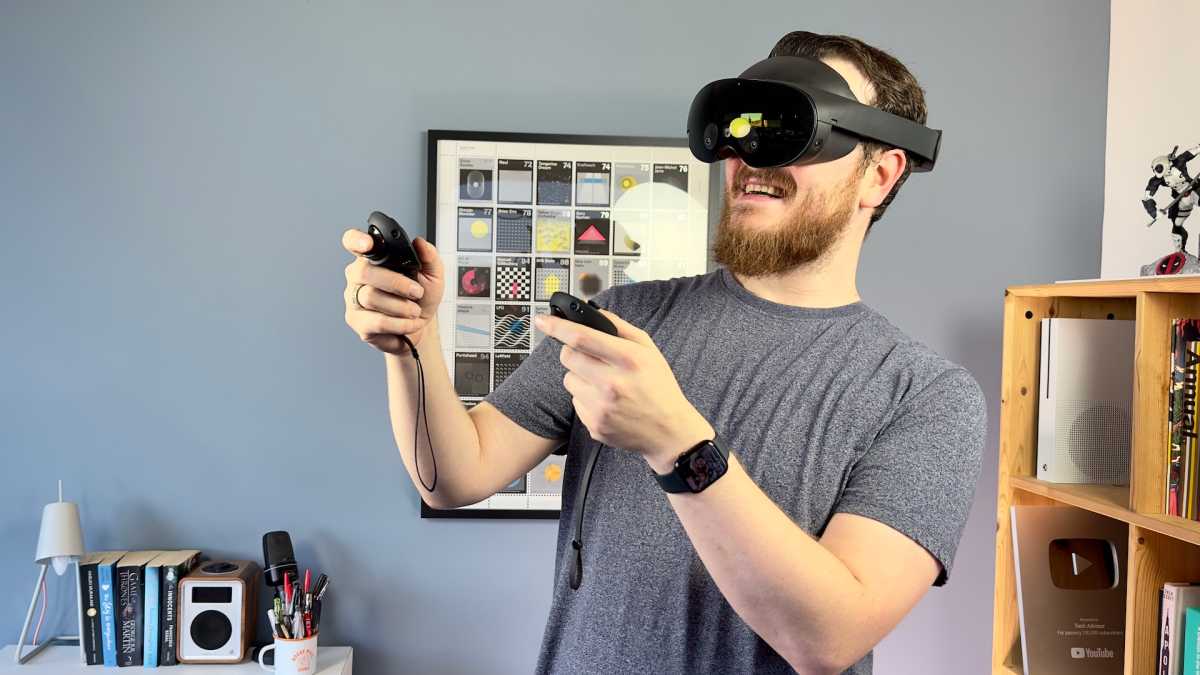
Lewis Painter / Foundry
The spatial audio is particularly effective considering the setup, with voices from friends in VRChat sounding like they were coming from behind me as they approached.
I’m left wanting more in the bass department, which could be a dealbreaker for VR music titles like Beat Saber, but there’s always got the option of plugging in a pair of headphones via the 3.5mm headphone jack for improved audio performance and more privacy too.
Controllers
- Completely redesigned controllers
- Tracking doesn’t rely on the headset
- More compact, easier to use
With the redesigned Quest Pro comes redesigned Quest Pro controllers, and they really are a huge improvement on the standard Quest offering.
The first thing I noticed is that they’re much more compact, fitting comfortably into the palm of my hand with easy access to all the buttons and triggers. The button layout is essentially the same as that of the Quest 2, allowing for easy cross-headset compatibility with games and apps, with a new inward slanted area to rest your thumbs when not in use.
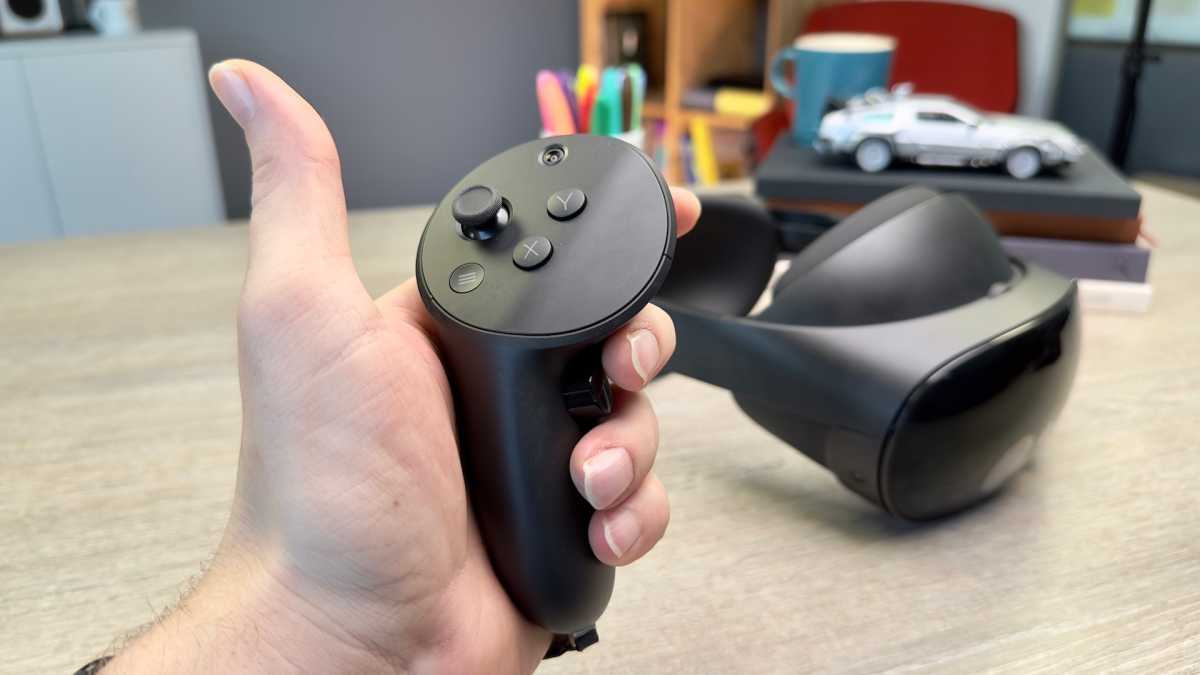
Lewis Painter / Foundry
The big change, as you might’ve noticed, is the removal of the tracking ring. This allows you to bring your hands closer together than ever before in VR (without hand tracking anyway!) without bumping the two large rings into one another. Paired with improved haptic feedback to better simulate the feel of whatever you’re holding or doing in VR, it’s a much more natural, immersive experience.
Of course, the standard Quest controllers don’t feature rings just for the fun of it, they’re used to track the location of the controllers by the headset. The Quest Pro controllers, on the other hand, boast a brand-new tracking system that doesn’t rely on the headset to track their location.
This is done using a smattering of small cameras across the controllers that, when combined with the Snapdragon 662 chipset found in each controller, can compute its position on the fly with true 1:1 accuracy. That means that there are no dead spots when tracking, no matter where the controllers are relative to the headset.
The freedom that controller-based tracking gives is relieving, especially when playing VR games like Blade and Sorcery: Nomad where you battle against human NPCs with swords, shields and magic powers (it’s a great game that I fully recommend if you haven’t checked it out!). While I occasionally lose tracking with the Quest 2 controllers, especially when reaching behind me to get my weapons, I didn’t experience that once with the Quest Pro controllers.

Lewis Painter / Foundry
They’re also ideal for fast-paced VR games like Beat Saber where reaction times are crucial. Not to blow my own trumpet, but I’ve managed to get a few perfect SS runs on Hard difficulty during my week or so with the Quest Pro, and I only ever achieved one on the standard Quest 2 over 2 years of playing on and off.
The Quest Pro controllers are also compatible with Quest 2 and will be sold separately for those looking to upgrade, though at $300/£300 a pop, I’m not sure how many will go for it.
Smart Features & Specs
- First headset to use the Snapdragon XR2+ Gen 1
- Eye- and face-tracking
- Mixed reality support via full colour passthrough
The Meta Quest Pro is the first VR headset on the market to feature Qualcomm’s updated Snapdragon XR2+ Gen 1 chipset alongside a boosted 12GB of RAM, and that means significant improvements.
That includes support for 8K@60fps 360-degree video, improved head, hand and controller tracking and a new image processing pipeline that supports full-colour passthrough (one of the headset’s main features) with just 10ms of latency, ideal for mixed reality applications – but more on that in a bit.
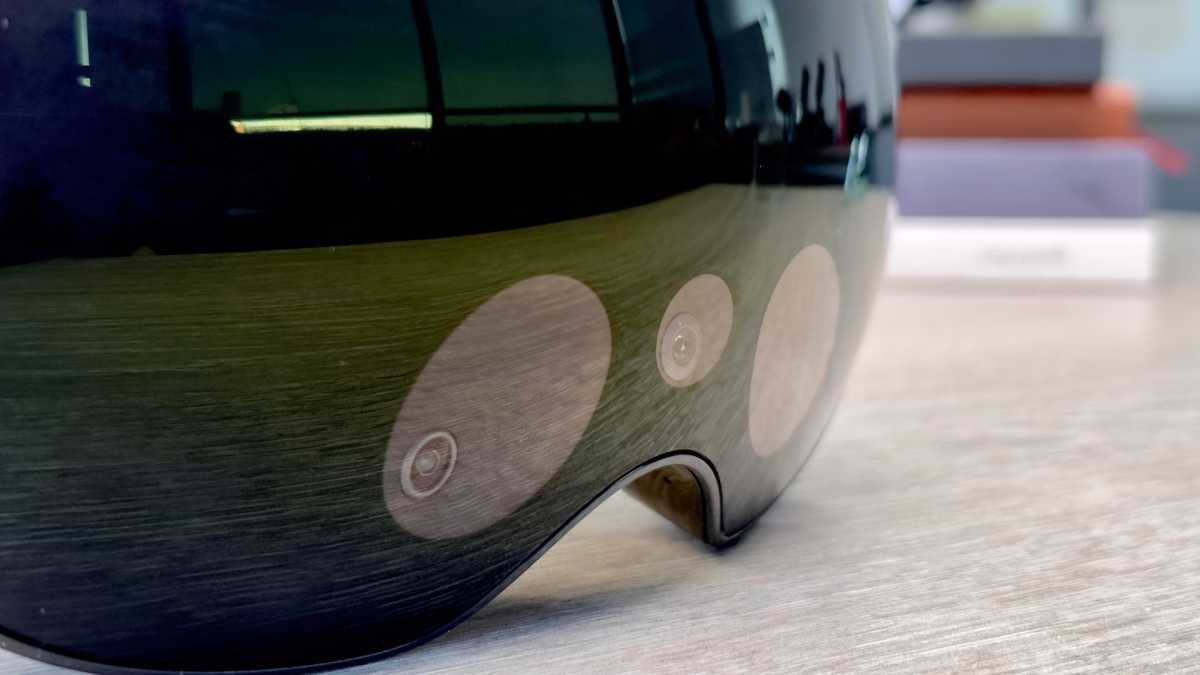
Lewis Painter / Foundry
Of course, there’s also a boost in pure brute power, with Meta and Qualcomm suggesting a 50% boost to processing power and 30% improved thermal performance that’ll keep it running optimally for longer periods.
That’s hard to quantify in use, as the standard XR2 is both a decent chipset and the chipset most VR devs have tailored their games for, so there aren’t many (or any, really) titles that can take advantage of the extra power right now, but it certainly futureproofs the headset.
What’s equally, or possibly even more, exciting are the additions of face and eye-tracking tech. A first for a Meta headset, the Quest Pro can map your gaze and facial expression and use this data in VR apps like Horizon Workrooms to provide a much more lifelike social experience in virtual reality.
The new tech means those you communicate with will be able to pick up on smaller nuances of human communication, like smirks when joking, a sarcastic wink or wide-open eyes and mouth when a colleague says something shocking during a work meeting.
When combined with the hand-tracking already available on the Quest headsets, it’s a huge leap forward for social VR and collaboration, helping make virtual communication feel more natural, lifelike and simply more memorable than staring at an expressionless avatar.
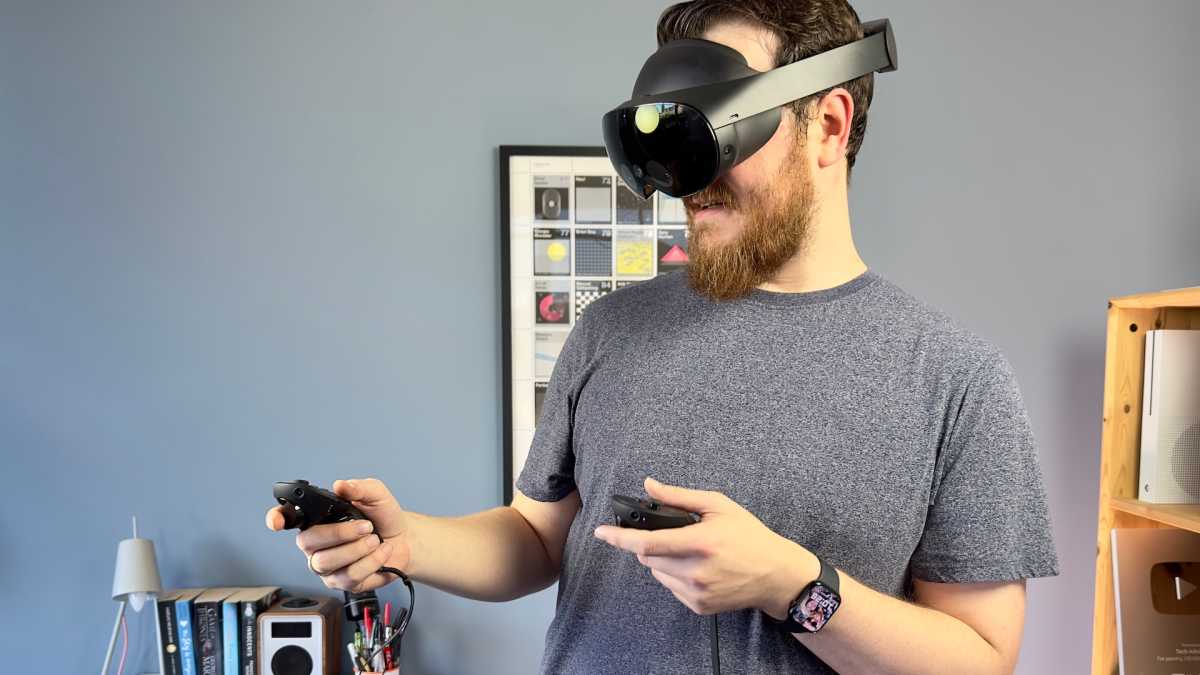
Lewis Painter / Foundry
However, this isn’t functionality that you’ll directly benefit from most of the time. The people you interact with will also need a Quest Pro to properly emulate their facial expressions and gaze, and chances are there won’t be many with such a high price tag, but I’m sure your VR friends will appreciate the new tech.
On a less exciting but still important note, the Quest Pro comes with a boosted 256GB of storage as standard, allowing you to install all kinds of VR games and MR apps without having to worry about running out of space. With some titles like Medal of Honor: Above and Beyond coming in at a whopping 44GB, the extra capacity is appreciated.
There’s also support for Wi-Fi 6E and Bluetooth 5.2, though the headset still can’t be used with Bluetooth headphones, unlike the competing Pico 4 headset.
The MR/VR experience
- Mixed reality is exciting, but not many apps use it at the moment
- Still need to manually map your room for MR
- VR experience is identical to Quest 2, except without full light blocker
While the Meta Quest Pro is just as capable as the Quest 2 when it comes to VR (virtual reality), the Pro model holds the upper hand when it comes to mixed reality, also known as MR (mixed reality).
That’s powered mainly by upgraded full-colour cameras mounted onto the front of the headset that boasts 4x the pixels of the standard Quest. That not only means you’ll be able to see your environment in colour for the first time,…
